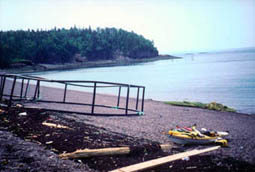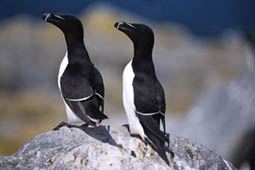
![]()
Volume 6, No. 4
Promoting Cooperation to Maintain and Enhance
Environmental Quality in the Gulf of Maine
|
|
|
|
|
|
|
|
|||||||
|
|
|
|
Browse the archive |
|
|
|
|
Gulf Log
Too much fishing debris
Debris from aquaculture, commercial fishing and other coastal industries has become an unsightly menace in the Bay of Fundy, Passamaquoddy region. Team members from this summer’s Gulf of Maine Expedition have called the discarded fishing-related materials piled along some islands in the Passamaquoddy region among the worst cases of marine debris sited in the entire Gulf. In a recent study on the issue released by Eastern Charlotte Waterways, Inc. (ECWINC) a non-profit group, in collaboration with the New Brunswick Salmon Growers Association and the Department of Fisheries and Oceans, researchers surveyed 27 areas off the coast of Charlotte County, New Brunswick, extending to the south from Letang Harbour to Deer Island, and to the east from Hog Island in Passamaquoddy Bay to Pocologan Harbour in the Bay of Fundy. In aerial surveys of the sites conducted in 2001, researchers recorded discarded aquaculture pens, plastic sheeting, 55-gallon drums, Styrofoam floats, weir poles and scatterings of plastics, wood, foam, rubber and metal. Among the study’s recommendations: a comprehensive recycling program for industrial marine debris; policies to cut down on packaging; and supplying workers with recyclable coffee cups.
In the meantime, ECWINC is urging aquaculture companies to clean up through its Adopt a Shoreline program. So far, says Loretta Tatton, who runs the program with Wendy Raymond, 27 companies have signed on to “adopt” and keep their beaches debris-free. After four years of promoting the program, “There are now quite a few shorelines that have been tidied up,” Tatton says. “Now you can go there and have a picnic and the garbage isn’t brushing up around you.” Tatton says that when people call the office and complain about aquaculture debris, “I can find the company that has adopted that shoreline, and ask them to send some of their staff over to pick it up. It’s made a big difference.”
 |
| Marine debris found along beach in Passamaqoddy Bay. Photo: Sue Hutchins |
Massachusetts shellfish beds restored
This past clamming season, Reggie Macamaux, Kingston, Massachusetts’ shellfish constable, would go down to the shore in the evenings to dig a peck of clams and see families enjoying themselves on mud flats recently brought back to health after decades of pollution.
It’s a “great feeling” to see people digging out there again, Macamaux says, after years during which the town’s shellfish beds were closed and the local mollusks unfit for consumption.
Some of the flats had been closed since 1926 and were contaminated enough that they reputedly caused a rash of typhoid. More recently, pollutants from sewer overflow pipes and septic systems fouled the bay water.
Macamaux remembers looking at the “beautiful bay” and asking himself “what can we do to clean it up?” He took his question to the Massachusetts Division of Marine Fisheries and set into motion what became a cooperative effort between the state and towns to clean the water flowing into the bay.
The state spent $55 million on sewage treatment and pollution abatement programs in the area. The towns of Plymouth and Kingston upgraded their wastewater treatment plants and Kingston installed a new sewer system to replace old septic systems that leached into Kingston Bay. The town of Duxbury made improvements to its septic systems, as well.
Macamaux and the Kingston harbormaster seeded their flats which are now home to a variety of shellfish including soft shell clams, sea clams, razor clams, cherrystones, littlenecks, quahogs, mussels and some scallops. The size of flats open for harvest are back to the way they were in 1926, Macamaux says.
“It’s a tremendous environmental success story, an example of how people really care about the restoration of their natural resources, “Robert Durand, secretary of the state’s Executive Office of Environmental Affairs, told the Boston Globe in September when EOEA celebrated the reopening of approximately 1,800 acres of clam flats in Kingston, Plymouth and Duxbury.
The effort also brought about more public awareness for keeping the bay clean.
Macamaux says that the next step is to get a federal “no discharge zone” designation for the bay under the Clean Water Act to stem pollution from boats’ head waste.
–Maureen Kelly
Marine invaders coming to a marsh near you?
The Asian shore crab, green fleece alga and rapa whelk aren’t exactly household names, but their reputations for preying upon, outcompeting and harming native marine life is spreading fast–literally. Once they take hold, crabs, fish, seaweed and other marine life introduced outside their native range can cause tremendous environmental disruption to coastal habitats and result in millions of dollars in damage. Next to habitat destruction, marine invaders are believed to be the leading cause of decreased biological diversity worldwide.
At a conference last month in Boston sponsored by the Massachusetts Bays Program, scientists and citizens from the Northeast discussed the current status of marine invaders in the region and efforts underway to control their spread. Eyes on the Estuaries: Preventing and Detecting Marine Invasive Species examined the approaches to monitoring for invasives such as rapid assessment surveys, aquatic nuisance databases and volunteer monitoring programs. The other main topic focused on tracking the pathways, or routes, of invasive species via ships, maritime activities such as oil and gas exploration, and the aquarium industry.
Judith Pederson, the manager of coastal resources for the Massachusetts Institute of Technology’s Sea Grant program, reported that $130 billion is spent annually on managing non-indigenous species in the United States, though it is not known how much of that is spent on marine species.
Pederson emphasized the need to identify all the vectors (the physical means or agents by which a species is transported) as an initial step to stem the tide of invaders, and to know the pathways for arrival and possible release points.
Ballast water and ship hull fouling are the primary vectors for invaders. About three to five billion tons of ballast water are discharged each year worldwide, transporting thousands of species to new waters carried either on the inside or outside of vessels. Citing the results of the National Ballast Water survey, Pederson said that New England does not exchange a lot of ballast water relative to other parts of the country. But among the New England states, Maine has the highest discharge rates due largely to the higher number of bulk carriers that visit the state’s ports.During a question and answer period, an audience member said that ship hull fouling poses a greater threat than does ballast water. He asked why more focus is not being placed on keeping invaders off ship hulls. Pederson responded that while hull fouling is a major concern, current national legislation regarding marine invasives is directed toward controlling and finding ways to treat ballast water, as a first step in engaging the industry to examine the issue. “We have a hurdle to get over to get the shipping industry involved,” she said.
Other known vectors for invasive species include the seafood industry (fishing industry and aquaculture), bait shops, marine laboratories, aquariums and pet stores.
 |
| North American razorbill Photo: Catherine M. Devlin |
In an interview at the conference, Jan Smith, the executive director of the MassBays program, said that invasive species of concern in the Gulf of Maine are the Asian shore crab, Atlantic green crab and codium (a seaweed). There is little that can be done about invaders already established here, he said. At this stage, the focus is on gathering the data that will help predict the next invasion.
Proceedings from the conference, due out early next year, will include summaries of presentations and discussions. For more information contact www.massbays.org.
– Maureen Kelly contributed to this article
GoMOOS now available on Dial-A-Buoy service
Information on weather and ocean conditions throughout the Gulf of Maine is now only a phone call away. The Gulf of Maine Ocean Observing System (GoMOOS) in partnership with the National Atmospheric and Oceanic Administration’s (NOAA) National Data Buoy Center (NDBC) have recently made GoMOOS real-time weather and ocean condition information available through the NDBC’s Dial-A-Buoy service.
Using a cell or touch tone phone to call the dial-a-buoy service at (228) 688-1948, anyone at anytime can receive the latest weather and ocean condition observations from sixteen buoys including ten GoMOOS buoys that are located throughout the Gulf of Maine. To hear observations from a specific buoy, the caller needs to enter the NOAA identifier number of that buoy. GoMOOS has produced a quick reference card that contains the dial-a-buoy calling instructions and the NOAA identifier numbers of the GoMOOS buoys. You can receive this card by requesting it from GoMOOS at (207) 773-0423 or from info@gomoos.org. Additionally, these identifier numbers can be found on the NDBC’s website at www.ndbc.noaa.gov.
For more information about GoMOOS visit the Web site at www.gomoos.org or phone (207) 773-0423.